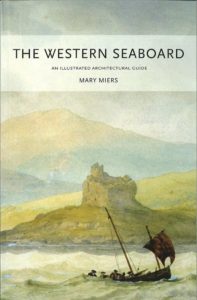 Drawing on a lifetime’s knowledge of this wild corner of Britain, Mary Miers takes us beyond the familiar sounds and scenery of the West Highlands and Islands to uncover an extraordinary record of human settlement, from the earliest ‘terraced’ houses on the machair of Bronze Age Uist to Scots Baronial piles set amid semi-tropical gardens. On the way, she encounters the shrines and strongholds of medieval Gaeldom; planned fishing stations, canals and railways; houses ranging from the fashionable to the vernacular and the Highland urbanism of Portree, Fort William and Stornoway. This richly illustrated handbook reveals how the architecture of the Western Seaboard has transformed itself through at least four cultures—a compelling story of survival and revival. It’s a story of holy men and holiday-makers, seafarers, warriors and crofters, and of the enduring influences of religion and clanship in the face of repeated waves of modernisation. This is the ideal accompaniment for anyone wishing to visit some of the most haunting landscapes in the world and learn something of those who inhabit them.
Drawing on a lifetime’s knowledge of this wild corner of Britain, Mary Miers takes us beyond the familiar sounds and scenery of the West Highlands and Islands to uncover an extraordinary record of human settlement, from the earliest ‘terraced’ houses on the machair of Bronze Age Uist to Scots Baronial piles set amid semi-tropical gardens. On the way, she encounters the shrines and strongholds of medieval Gaeldom; planned fishing stations, canals and railways; houses ranging from the fashionable to the vernacular and the Highland urbanism of Portree, Fort William and Stornoway. This richly illustrated handbook reveals how the architecture of the Western Seaboard has transformed itself through at least four cultures—a compelling story of survival and revival. It’s a story of holy men and holiday-makers, seafarers, warriors and crofters, and of the enduring influences of religion and clanship in the face of repeated waves of modernisation. This is the ideal accompaniment for anyone wishing to visit some of the most haunting landscapes in the world and learn something of those who inhabit them.
ON-LINE 5-STAR REVIEWS of The Western Seaboard
*****Outstanding scholarship
“Every now and then a book comes along which takes your breath away. This is a work of simply outstanding scholarship. Every building of note (and a lot that have been almost wrecked by 20th century additions) in a vast area of Western Scotland is covered in this book.
Almost every building discussed is illustrated either with photographs or contemporary illustrations. The book has three main stories to tell. Firstly the ‘ancient’ history of Scotland, the rival clans and growth of towns right up to 1745. Secondly the awful ethnic cleansing which resulted from the ‘sale’ of clan land mainly to Southern industrialists (and the odd billionaire drug dealer); the resulting clearances to make economic farms and sporting estates simply wiped many villages off the map. At least two landlords even refused the people the right to build a church; one area reclaimed land by throwing stones in the sea, another brought in a floating church! Lastly we see how hard-up Highland councils have allowed almost any addition to historic houses in the post-1945 era, the chance of a job or two meaning the wholesale abandonment of any Highland or island style—usually replaced by tacky square extensions and houses of every suburban style possible. This book shows clearly that we live in an era of barbarism.
So, if you travel to any part of the Western Highlands and islands, this is an essential book for you. Did I mention that it is written with great wit and clarity? In short worth well more than the 5 star max. rating.”
Richard Gollin, 20 June 2010
*****An invaluable guide to the buildings & settlements of the Western Isles
“A vibrant informative book. Accessible to casual reader, can be dipped into easily. Great fun to read, as well as informative. It was really useful in the field, helping interpret buildings and their context.
Covers the full range of buildings, including vernacular—sheds, byres, cottages and houses—as well as the products of architects. Great background on human history and associated development of buildings and settlements.”
Earthbound flyer, 23 Sept. 2009
*****This is what I was looking for!
“This excellent architectural review of some of my favourite parts of western Scotland is ideal for learning of the places that you might zip by on a car trip. It is clearly written, with enough history to keep it in context. My next trip to the area will be modelled around the ‘finds’ I have made in this book. Mary Miers is my new heroine for knowing what is important in the area’s architectural heritage. I truly hope to see more books like this. It sounds like it could be a series, but this is the only one I have found so far. But this one covers the most important area for me. I cant wait to go get stuck on some back road trying to get a glimpse of some obscure or forgotten architectural treasure.”
Deborah A. Morse, 7 May 2011